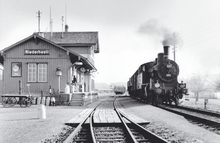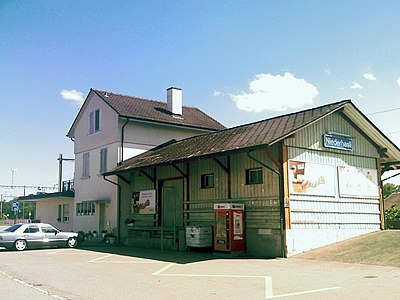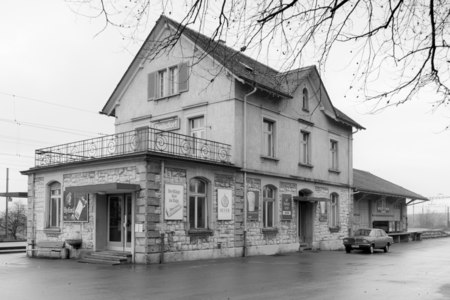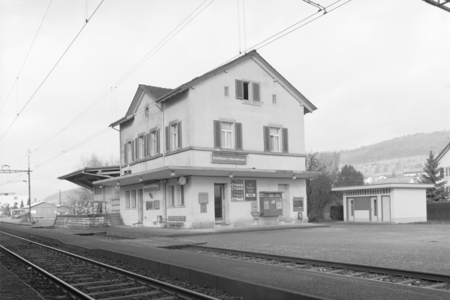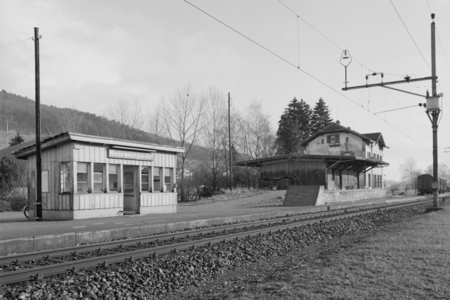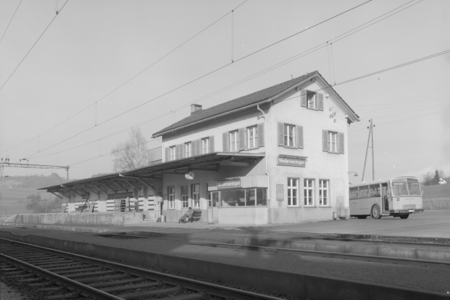Wehntalbahn
| Wehntalbahn | |||||||||||||||||||||||||||||||||||||||||
|---|---|---|---|---|---|---|---|---|---|---|---|---|---|---|---|---|---|---|---|---|---|---|---|---|---|---|---|---|---|---|---|---|---|---|---|---|---|---|---|---|---|
| Timetable field : | 760 | ||||||||||||||||||||||||||||||||||||||||
| Route length: | 12.07 km | ||||||||||||||||||||||||||||||||||||||||
| Gauge : | 1435 mm ( standard gauge ) | ||||||||||||||||||||||||||||||||||||||||
| Power system : | 15 kV 16.7 Hz ~ | ||||||||||||||||||||||||||||||||||||||||
| Maximum slope : | 20 ‰ | ||||||||||||||||||||||||||||||||||||||||
| Minimum radius : | 350 m | ||||||||||||||||||||||||||||||||||||||||
| Oberglatt – Niederweningen | |||||||||||||||||||||||||||||||||||||||||
|
|||||||||||||||||||||||||||||||||||||||||
The Wehntalbahn , also known as the Wehntallinie or the Oberglatt – Niederweningen line , is a standard-gauge railway line in the Swiss canton of Zurich .
history
Oberglatt – Niederweningen village
The first section from Oberglatt to Dielsdorf was opened on May 1, 1865 by the Bülach-Regensberg-Bahn (BR), as a branch line from the main line Oerlikon - Bülach, which was opened at the same time . With regard to the goods to be expected, the new line was also known as the Herdöpfelbahn ( Zurich German for potato railway ).
The BR was taken over by the Nordostbahn (NOB) on January 1, 1877 . The extension of the branch line into the Wehntal was already planned at that time, but was delayed due to years of disputes about the route and the location of the stations, as well as a lack of money at the NOB. The line to Niederweningen - today's Niederweningen Dorf railway station - was opened on August 12, 1891 by the NOB. During this time, the nickname Djibouti - Adisabeba and Djibouti Railway , which are still widespread among railway staff today , is likely to come from. During the construction of the railway, the bones of mammoths were found in a gravel quarry in Niederweningen .
Surb Valley Railway
The NOB was nationalized on January 1, 1902 and merged with other large private railways to form the Swiss Federal Railways (SBB). The wish of the Aargau communities in the Surbtal for a rail connection from the greater Zurich area to Waldshut , which was already circulating in the middle of the 19th century, was taken up again in 1915. On November 21, 1916, the construction of which was Surbtalbahn in a Federal Law ( SR arrested and 742.34) in the April 14, 1917 optional referendum confirmed.
The construction of the Surbtalbahn from Niederweningen to Döttingen on the NOB railway line Turgi – Koblenz – Waldshut , opened in 1859, never happened. The project was put on hold again with the deletion of SR 742.34 in the course of 1937.
Niederweningen Dorf – Niederweningen
The last extension of the Wehntalbahn took place on May 15, 1938, when the almost one kilometer stretch to the canton border was opened. A house in the village center of Niederweningen had to be torn down for the construction of the route. Since the new end of the route at the factory and headquarters of the mechanical engineering group Bucher Industries was named Niederweningen , the train station in the center has been called Niederweningen Dorf ever since .
electrification
Due to the subordinate importance of the route through the relatively sparsely populated Wehntal, there were no major expansion projects. Although a diesel railcar operated on the Mittelthurgau Railway on a trial basis in the 1950s, steam operation in the Wehntal remained for a long time. After it was decided not to stop operations on the line, the track's superstructure was reinforced and it was electrified with alternating current (15 kV 16⅔ Hz). The last steam train ran on May 28, 1960, with the wreathed Eb 3/5 5804 being used as the locomotive. With the opening of electrical operations on May 29, 1960, the penultimate SBB route, on which regular passenger traffic was handled by steam locomotives, disappeared. Steam locomotives only ran for a few weeks longer in Ticino on the Cadenazzo – Luino line.
In the course of electrification, simplified security systems were introduced at the partially unattended Schöfflisdorf and Niederhasli stations. The old mechanical lever interlockings and the entry signals have been removed and the manual switches have been fitted with locks. The keys could only be withdrawn in the basic position of the switch and had to be put in a key box before the exit signals of the served neighboring stations could be set to travel.
Originally, all subway stations on the single-lane route were provided with sidings that allowed crossings. Until the end of the seventies there was still a lot of freight traffic. The main customers were the Bucher agricultural machinery factory , the mill in Steinmaur, the Maag company and the BMW general agency in Dielsdorf and the sawmill in Niederhasli. In the eighties, the sidings at the stations were only used as sidings for surplus bulk goods wagons from Weiacher Kies AG .
Until the renovation of the station in Oberglatt as part of the introduction of the double track on the Bülach – Oerlikon line in 1985, the trains of the Schaffhauser line crossed in front of the train running into the Wehntal, which was on platform 4. At an intersection, the train coming from Zurich entered platform 2 and the passengers had to get off towards the station building. Invisible to the passengers, the train from Schaffhausen entered platform 3 behind the stationary train from Zurich , before the former continued its journey to Schaffhausen. The now visible train to Zurich was often mistaken for the train to the Wehntal by the waiting passengers, so they got on the wrong train and drove back to Zurich instead of going to the Wehntal. The train to the Wehntal was only accessible to passengers after the train to Zurich had left the station.
Up to the opening of the S-Bahn, mainly BDe 4/4 shuttle trains were used on vehicles, which replaced the De 4/4 shuttle trains in the 1960s. During the morning peak of traffic in the direction of Zurich, an Ae 4/7 with heavy conversion wagons was used, which left Niederweningen at 6 a.m. and went directly to Zurich. The four-part BDe 4/4 shuttle train at 7 a.m. received two lightweight steel cars as reinforcements. With this train, the railcar reached its load limit when approaching the 18 ‰ ramp near Schöfflisdorf, so that inexperienced train drivers often triggered the maximum current relay and the approach had to be repeated. Before the S-Bahn opened, more and more RBe 4/4 shuttle trains were used. A reinforcement train with Be 4/6 also ran for a short time during the Morgenspitze from Dielsdorf to Oerlikon. RABDe 12/12 came to the Wehntal less often.
Ae 4/7, which led the midday freight train from Niederweningen, were used for freight traffic. In the 1980s, the sawmill in Niederhasli occasionally received imported timber trains with French wagons, which were taken with Re 6/6 to the siding of the sawmill.
Integration into the Zurich S-Bahn
In preparation for the S-Bahn operation, most of the side tracks were removed and all stations equipped with new 220 m platforms and waiting rooms. Most of the stations had not been occupied for several years and were rented out for private use. Train crossings are only possible in Dielsdorf.
The railway systems have been simplified. The private sidings were only left in Steinmaur for the grain silo and the sugar beet loading. The largest railway system on the line is located at its end point in Niederweningen, where there are several tracks that form a small group of siding for S-Bahn trains on the one hand and lead to the Bucher factory area on the other.
When the Zurich S-Bahn began operating on May 27, 1990 , the people of Wehntal were given daytime connections to Zurich for the first time. All trains were converted to DPZ , although due to the length of the platform, only double units could run at first , but not three-part compositions. The trains ran as S 5 on the Pfäffikon SZ - Zurich –Oberglatt – Niederweningen route. A special feature of the S 5 was the operation of two alternating endpoints in the Zürcher Unterland . The trains ran between Pfäffikon and Oberglatt every half an hour, from Oberglatt the trains went alternately to the Wehntalbahn or to Bülach - Rafz , so that there was only one hourly service on these branches. During the morning peaks, some trains were initially united in Oberglatt, but this often led to technical disruptions. The last train from Zurich was split in Oberglatt, so that one DPZ went to Wehntal and the other to Rafz.
As early as 1991, due to the high number of passengers, further expansions were necessary - especially in the P&R facilities , which were also used by commuters from southern Germany . The parking spaces in Niederweningen and Niederweningen Dorf were expanded and subject to charges, which diverted traffic to the parking spaces in Schöfflisdorf, which were still free at the time, so that an expansion was necessary there and a bus turning loop was created for line 555 to Schleinikon . In the same year, the 100th anniversary of the route was celebrated with a steam train hauled by the C 5/6 2978 .
General cargo traffic in the Wehntal was maintained until 1994. The "trains" consisted of a car and an Ae 4/7 until the end, more rarely also other locomotives such as Ae 6/6, Re 4/4 II or even Re 460 . After that, the Wehntal was served by an Em 3/3 from Niederglatt . The two shunting tractors stationed in Dielsdorf disappeared.
In 2004, an EW III composition was used as a morning reinforcement train as a curiosity , which was later temporarily replaced by an EW IV composition .
In 2006 the regular freight traffic in the Wehntal disappeared, only the Steinmauer mill was still operated when required, and sugar beets could only be loaded in Steinmaur and Niederweningen.
For the timetable change on December 10, 2006, the S 55 (Oberglatt – Niederweningen) was introduced, which runs every hour on weekdays on the Wehntalbahn and together with the S 5 from Bülach – Rafz offered a second travel option per hour and direction, which, however, required a change in Oberglatt made necessary.
At the end of September 2007, the entire route between Oberglatt and Niederweningen was connected to the Zurich Oerlikon remote control center. Only Dielsdorf train station is still open for ticket sales and customer advice.
From 2013 onwards, the S5 running from the Wehntal in the direction of Uster in the Abendspitze reached the limit of capacity that a two-part DPZ composition was no longer sufficient to transport passengers away from Zurich at 5:30 p.m. The train therefore had to be replaced in Oberglatt by a three-part composition. Since the introduction of the S-Bahn, this has created the first and only transfer connection in the basic cycle of the S 5 .
Fourth partial addition to the S-Bahn
With the timetable change at the end of 2015, as part of the fourth partial expansion of the Zurich S-Bahn, all stations on the route were provided with 320 m long platform edges so that longer trains, such as triple compositions of DPZs, can run. This expansion, costing 26 million euros, enabled the introduction of half-hourly connections to Zurich without changing trains. With the timetable change, the S 55 was canceled and the western branch of the S 5 was swapped for that of the S 15 , so that the S 15 Rapperswil - Uster - Zurich HB - Oberglatt - Niederweningen now serves the Wehntal. With this changeover, the alternating endpoints of the S-Bahn line were also eliminated, because the trains in the direction of Bülach became line S 9 Schaffhausen - Rafz - Zurich HB - Stettbach - Uster .
However, this change meant that long-distance trains running every hour on the hour were not optimally reached in Zurich HB because the S-Bahn trains arrive seven minutes after the hour.
Train stations
Originally, station buildings from the Nordostbahn era were to be found along the entire route. In the course of the expansion as part of the fourth partial expansion of the S-Bahn, the reception buildings in Steinmaur , Schöfflisdorf-Oberweningen and Niederweningen were demolished and replaced by new waiting areas with elements from the RV05 construction kit. The siding in Steinmaur also disappeared.
Demolished around 1984 and the pedestrian bridge to Oberhasli replaced by an underpass
literature
- R. Wanner: 50 years ago : Railway extension near Niederweningen In: Railway Amateur 10/1988, pp. 705–710
- R. Wanner, St. Frei: The SBB in Wehntal and Surbtal - Part 1: Wehntal In: Eisenbahn Amateur 5/2010, pp. 250–259
Web links
- Hans-Peter Christener: Wehntalbahn. 1960, accessed on September 20, 2014 (film from the steam company).
Individual evidence
- ↑ Hans G. Wägli: Track Profile Switzerland 2005 . Diplory Verlag, Grafenried 2004. Route display according to profile 753.
- ↑ Federal resolution regarding extension of deadlines for the railways: Aargau Southern Railway, Glarus – Linththal, Thalweil – Zug, Etzweilen – Schaffhausen, Bülach – Schaffhausen, Koblenz – Stein, right bank Zürichseebahn, Dielstorf – Niederweningen. In: Swiss Government (Ed.): Federal Gazette . 29th year, no. 4 , 1877, p. 753-754 .
- ↑ Dead railway landscapes? In: SEAK (Ed.): Railway Amateur (EA) . No. 8 , August 2006, p. 448 .
- ↑ News in brief: SBB traction vehicles . In: SEAK (Ed.): Railway Amateur . No. 3 , 1961, pp. 73 .
- ^ Hans Wismer: Farewell to the steam in the Wehntal . In: SEAK (Ed.): Railway Amateur . No. 7 , 1960, pp. 199 .
- ↑ News in brief: SBB systems . In: SEAK (Ed.): Railway Amateur . No. 7 , 1960, pp. 200 .
- ↑ News in brief . In: Railway amateur . No. 1 , 1992, p. 15 .
- ↑ News in brief . In: Railway amateur . No. 1 , 1992, p. 15 .
- ↑ News in brief . In: Railway amateur . No. 8 , 1993, pp. 501 .
- ↑ News in brief . In: Railway amateur . No. 3 , 1994, p. 147 .
- ^ R. Wanner, St. Frei, page 259
- ↑ News in brief . In: Railway amateur . No. 12 , 2004, p. 711 .
- ^ R. Wanner, St. Frei, page 259
- ↑ Timetable and use of rolling stock 2013 . In: Railway amateur . No. 3 , 2013, p. 110 .
- ↑ Timetable field 760, train numbers 18071 and 18075 . In: fahrplanfelder.ch . 2013, p. 6 .
- ↑ Expanded train stations allow every half hour in the Wehntal. In: Zürcher Unterländer. Retrieved January 1, 2016 .
- ↑ 4th partial supplement: Zurich - Oberglatt - Schaffhausen / Niederweningen. ZVV, 2016, accessed on January 1, 2016 .
- ↑ News in brief . In: Railway amateur . No. 4 , 2014, p. 172 .

